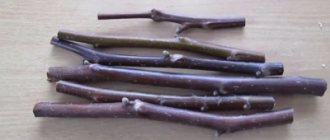Willow hedge.
Photo from the site rose-club.ru Or even for a gazebo:
Living gazebo made of willows. Photo from thewillowbank.com
But I think not every willow can be planted this way. Yes, willow propagates by cuttings. You can also use seeds, but I read that willow seeds are only viable for a week. Maybe it's a lie?
In any case, the tree grows faster from cuttings.
- Cuttings are harvested in the off-season. Ideally - in November or February-March, when sap flow is slow. We choose shoots that are at least 2 years old: there is a greater chance that the branch will take root. Cuttings are cut from the middle of the branch; their length should be about 30 cm.
- Did you cut it? Then we plant it in the ground. For now, at home or in the greenhouse. If you plant several cuttings in one container, the distance between them should be 20-30 cm.
Ideally, willow should be planted in a permanent place in the second year after planting, when the root system has already formed. They are also planted in the spring, when the snow has melted. To do this, dig a hole of a certain size. For a low-growing willow, a hole measuring 50x50x50 cm will be enough; for a tall willow, make a larger one. We loosen the soil of the hole, fertilize it with humus and moisten it abundantly. And bury the root of the cutting. All.
Do not forget to water the willow at first, when it is sick from transplanting. Now let's talk about how to care for willow.
Features and types of plants
Willow belongs to the shrubs and has more than 300 species. Some of them are successfully grown by gardeners on their plots. The plant has beneficial properties and is used in medicine, cosmetology, and various crafts. Thanks to its grace and extraordinary appearance, the tree has earned many poetic descriptions in literature and songs.
A unique feature of the weeping willow is its beautiful crown, which appears translucent from a distance. The branches are drooping, falling down vertically - this is what a talnik tree looks like. The flowers are collected in inflorescences called catkins. Most species reach a height of 15 m, but there are also dwarf species that grow no higher than 2-3 m. In nature, giant willow specimens up to 40 m high are found.
In landscape design, shrubs are planted alone and together with other plants. Willow is not placed in groups, as it requires a lot of space. Dwarf varieties look great on alpine hills, and medium ones are planted along the site, forming a hedge. Mature plants are tolerant of pruning and can be used to create interesting shaped compositions.
If there is an artificial pond on the site, the willow will take its rightful place there, framing a stream or pond with its branches. In conditions of high humidity, the tree feels great, and at the same time creates a pleasant shade under which garden owners can relax. Shrubs are often planted on slopes to prevent further shedding. Willow has a powerful and branched root system, which prevents the soil from crumbling.
Since there are about 3 hundred species of willow, not all are given here, but only those that have pronounced decorative properties. They can be cut, planted in a row or singly. Any of these willows will decorate your garden plot:
- Babylonian. Tree up to 15 m high, with a voluminous crown and weeping branches. The foliage is shiny, the shoots hang to the ground. Grows quickly in moist soil.
- Goat. Looks more like a tree than a bush. The leaves are rich green, rounded, and densely spaced. The crown can be spherical or irregular in shape. During flowering, the plant exudes the aroma of honey.
- Creeping (Armando). You can’t see the trunk behind the branches of this shrub, they are so thick. The crown is very lush and voluminous, as are the pink flowers, which seem fluffy from a distance. Tolerates low temperatures well, suitable for growing on loggias, terraces, balconies and in open ground.
- White. Long-lived shrub: grows up to 100 years. Feels good on the banks of rivers and lakes, next to springs and streams. The leaves are silver, the flowers are yellow, collected in long earrings. The tree grows up to 25 m.
- Crying. A distinctive feature is the yellow bark, which gives a decorative appearance. The branches drop very low, as if they were crying, which is why the willow is a weeping one. At the same time, the tree itself does not grow large and looks great in a flower bed.
- Haruko Nishiki. A low shrub with drooping branches and spotted leaves. Spotting does not appear on mature trees.
- Hairy. The species got its name because it appears pubescent. It grows up to 2 m, has round leaves and light catkins. Feels good in harsh climatic conditions and is not damaged by frost damage.
- Entireleaf. Sprawling bush with arched leaves. The structure of the shoots is almost like that of a fern. During flowering, it is covered with a scattering of reddish catkins, fragrant with a hyacinth aroma.
This is a shrub with thin branches, most often not exceeding one meter in height and striking in its elegance. The bark is yellow with a bluish tint. Thin branches hang almost to the ground. The crown of the bush is dense and consists of opposite leaves ranging from 3 to 13 cm in length.
Linear-lanceolate stipules reach a length of up to 1.8 cm and fall off very early. During flowering, densely flowered, cylindrical catkins appear.
There are not many species of this plant. The following varieties are popular.
Variety Nana
A low, spherical shrub reaching a height of up to 1.5 m and a width of up to two meters. The plant has a well-developed root system, which allows it to be used to strengthen the soil cover. Its shoots are thinner than those of the main species. They are brown with a red tint. The plant begins to flower in early spring, before or along with the leaves.
The shrub is characterized as frost-resistant and light-loving. It tolerates dry periods well and recovers quickly after pruning. Purple willow Nana is used in landscape design to strengthen and decorate the banks of various bodies of water. It can also often be found in bush groups in flooded areas. Nana is used in hedges and gardeners use it to create different shapes.
Iva Pendula
The shrub has a weeping crown shape with blue-green leaves. The plant tolerates prolonged flooding well, but is also considered drought-resistant. Willow tolerates the cold season well. It is used to decorate garden plots and strengthen the shoreline of reservoirs. This plant is propagated by grafting onto a standard.
Both types are distinguished by their unpretentiousness. However, it should be borne in mind that when planted on the shady side, the crown of these plants may change its shape and, as a result, lose its attractiveness.
Weeping willow is rarely found in summer cottages, but some gardeners still include it in garden compositions. She feels best near natural or artificial reservoirs.
The plant is distinguished by a variety of species, which are represented by trees and ornamental shrubs. All of them are unpretentious, and therefore easily adapt to different climatic conditions.
Among the famous varieties are:
- White willow. A tree up to 25 m high can be called a long-liver, since its lifespan reaches 100 years. It got its name from the foliage, the lower surface of which is painted silver. Flexible long branches form a weeping crown descending to the ground. The bark is brown, with a pronounced yellow tint.
- Babylonian willow. Another long-liver, capable of growing up to 15 m. The narrow-lanceolate leaf plates are green with a bluish tint. Flexible, thin, shiny shoots of a reddish or greenish-yellow color hang down. The tree will grow much faster in well-lit areas near a water source.
- Shaggy dwarf willow. The plant is a low shrub (up to 2 m), different from other varieties. The branches are thick and knotty. Downy, rounded leaves, dark on one side and silvery on the other. It is often used in landscape design, since the crown can be given any shape.
- Goat willow. Most often the plant can be found in park areas. The tree itself is small and compact, with stems hanging to the ground. The foliage is rich green in color and rounded in shape. It has a sweetish aroma during the flowering period.
Weeping willow requires little care and is easy to grow.
This video presents interesting species and varieties of weeping forms.
Landing rules
In order for the weeping willow to take root well and feel comfortable, certain agrotechnical rules must be followed when planting it.
The best time to plant seedlings with an open root system is early spring. After the end of frost, they are planted in open ground until the juices begin to flow.
You can also carry out the procedure in late autumn, just before wintering. However, varieties that are less resistant to frost may not survive the winter well.
Experienced gardeners recommend covering young plants with spruce branches and mulching the soil with fallen leaves or pine needles.
Seedlings with a closed root system can be planted any time from March to November.
Any location that is not in full shade is suitable for growing weeping willow. It does not grow in low light conditions. The plant is best planted in the sunny part of the summer cottage, where groundwater is close to the surface.
We invite you to familiarize yourself with what the fruits of ash, maple and linden look like?
The tree does not like dry soil, so it needs to be planted in light sandy or loamy soil. For better willow growth, it can be mixed with humus or compost.
Willow grows well in sun-exposed areas of the garden
Selection of seedlings
A healthy, beautiful tree can only be grown from good, properly prepared seedlings:
- they must be winter stem;
- well lignified;
- 1–2 years old;
- prepared before the juices begin to flow or before the first frost.
Before planting, the seedlings are placed in a container with sand or water, and as soon as the buds bloom, they are transplanted into open ground.
First of all, you need to dig a planting hole 40 cm deep. For a tree, its diameter should be 60 cm, for a bush – 50 cm.
Light soil does not need to be drained, but heavy loams require a drainage layer (20–30 cm) consisting of river sand or small stone. The soil mixture should contain soil, compost and peat.
Gardeners also recommend adding 200 g of azofoska to it, mixing well and filling one third of the hole.
Rules for planting weeping goat willow
Weeping willow requires minimal care, so growing it in your summer cottage will not cause much trouble.
Watering and fertilizing
Since the tree loves moisture very much, it needs to be watered frequently and abundantly. One plant needs 20 liters of water once a week. In case of prolonged absence of precipitation, the volume is at least doubled. It is better to water in the morning, when the sun has not reached its peak, or in the evening. It is necessary to moisturize not only the roots, but also the green part of the willow.
The tree is fertilized 4 times a year. Before the buds ripen, the soil around the trunk is loosened and covered with a layer of peat mulch. Fertilizing with complex fertilizers is carried out 2-3 times until July. At the end of August, the soil is fed with potassium-phosphorus compounds (superphosphate, potassium sulfate).
Types of willows
The most common types of willows in the wild are:
White willow (Salix alba)
It is also called willow or willow. The tree reaches a height of 35 meters. The trunk is usually very thick.
White willow (Salix alba). Photo: Willow, ru.wikipedia.org
Babylonian willow or weeping willow (Salix babylonica)
This one grows mainly near bodies of water.
Babylonian willow, or weeping willow (Salix babylonica). Photo from tvemhaber.com
But I say again, it has taken root well with us. By the way, why crying? Usually this means a special crown shape with sad drooping branches, but it doesn’t always happen like that. Have you ever walked under the willows on a hot, sultry day? It's amazing! You are exhausted from the heat, and then large cold drops fall on you! Babylonian willow is recommended for use when growing in bonsai style. In indoor conditions it grows up to 60 cm. And if you constantly shape it, it will be a nice little tree. Well, if you grow it outside and don’t cut it, it will be weeping.
Goat willow (Salix caprea)
Tree or tree-like bush. And goat - because goats adore it. The peculiarity is that if you remove the bark, the wood turns red very quickly. In addition, this willow blooms like a willow. Men's earrings are oval, women's are cylindrical.
Goat willow (Salix caprea). Photo: Marina Skotnikova, plantarium.ru
We have plenty of them in the swamps. I remember every year after school they would break branches and take them home. By the way, this is not easy to do, so we went with scissors)) You can read about your personal experience of growing goat willow in the publication New plant in my garden: goat willow, or Bredina (Salix caprea).
Norway willow (Salix acutifolia)
She's a willow, or red.
Norway willow (Salix acutifolia). Photo: Igor Pavlov, plantarium.ru
Ash willow (Salix cinerea) is also worth mentioning Its leaves are wrinkled and as if covered with felt.
Ash willow (Salix cinerea). Photo: VSV, ru.wikipedia.org
Planting willow cuttings in autumn
Willow can be an excellent decoration for your site. In landscape design, this tree is used in composing compositions, arranging living gazebos and hedges. In order for cuttings of a cultivated willow variety to take root and form a powerful root system, it is necessary to follow the planting technology.
I thought that the topic of cuttings was already closed, but some readers had questions. In order not to answer everyone individually, I decided to devote another page to the preparation of cuttings. Well, look, or rather read.
For each type of woody plant, it is important to establish the most favorable period for cuttings, which is determined by the calendar period and the degree of lignification (young shoots rot easily, their immature tissue is not able to form roots). In the middle zone of the European part of the former USSR, the period from late May to early July is considered optimal for rooting green cuttings of deciduous trees.
In the early stages of this period, rooting proceeds better; in addition, the entire shoot, the lower part of which is semi-lignified and the upper part is green, is used for cutting cuttings. At later stages of this period, when the deciduous tree has finished growing, almost a third of the shoots prepared for cuttings are not used.
The best time for green cuttings of varietal lilacs and mock oranges occurs during flowering (cuttings should not be taken from shoots that have flowers or flower buds), and for a number of other species and forms of deciduous trees - during the period of intensive shoot growth. Summer cuttings in a greenhouse using strong lateral shoots of the mother plant “with a heel” or apical cuttings are recommended for barberry, euonymus, buddleia, weigela, wolfberry, hydrangea, honeysuckle, cinquefoil, viburnum, cotoneaster, broom, rhododendron, etc.
Conifers are cut either in the spring, before the buds begin to swell (for example, shoots of western thuja, spruce, fir and junipers are harvested from late April to early May) or in the summer, when they finish active growth (from mid-June to mid-July). The current year's shoots are cut into cuttings when they are still quite flexible and the bark is green.
In most species of woody plants, cuttings are taken from the middle part of the shoot, discarding the upper part that is too soft and the lower part that is too woody. When cutting a cutting from the upper part of a full-fledged shoot of deciduous and coniferous trees (the so-called apical cutting), the apical bud is left on the cutting.
It is better to cut shoots into cuttings early in the morning or on a cloudy day (to reduce evaporation from the cuttings); large leaf blades are shortened by half and the cut shoots are placed with their lower ends in a vessel with water. For successful root formation, the length and thickness of the cutting are important (very thin cuttings are undesirable).
When preparing cuttings, use a sharp knife to make a beveled cut directly under the bud or 1 cm below the bud. A straight upper cut is made above the kidney. To reduce transpiration, the lower leaves of the cuttings are removed, and large ones are cut in half. It is better not to cut off the leaves of plants that are difficult to root.
Cuttings should be harvested in a shaded place, constantly spraying them with water, since the cut shoots should not be allowed to dry out or even wilt.
Before planting, the cut cuttings are placed in a container with a small amount of water, sprayed and covered with a damp cloth. Cuttings of some plants that cannot tolerate prolonged exposure to water are placed in damp peat or plastic film. Freshly cut cuttings of coniferous plants (pine, spruce, larch) must be kept in water for 2-3 hours (since a resin is released on the cut surface of their cuttings, which prevents the absorption of water from the substrate after planting);
When propagating trees and shrubs using lignified (“winter”) cuttings, strong, mature annual shoots are used for cutting cuttings (for poplars and willows, sometimes even two-year-old shoots and older). Woody cuttings are often used to propagate mock orange, privet, honeysuckle, hydrangea, snowberry, tamarisk, spirea, buddleia, weigela, forsythia, deutzia, elderberry, kerria, cinquefoil, and currants.
Shoots of woody plants are harvested for cuttings either in the fall after leaf fall, or during the winter dormancy period (November-February), or in early spring before the buds swell. Cuttings taken from young shoots from the lower part of the trunk of the mother plant take root better. To prepare cuttings, it is good to use the shoots formed after pruning the tree “to a stump”.
The easiest way to root cuttings of deciduous trees is to plant them in the fall after leaf fall in open ground (in the partial shade of the garden, in well-drained soil). Cuttings are cut from the lower and middle lignified parts of the shoots immediately before planting (in this case, “soaking” of the lower cut is allowed). The thickness of the cuttings is usually 7-12 mm, length 20-30 cm (for rooting in greenhouses, cuttings are cut 4-10 cm long).
In deciduous plants, cuttings cut in autumn (after the period of leaf fall) no longer have leaves, and in evergreen plants, leaves are removed from the lower and middle parts of the cutting (only the upper third of the length of the cutting remains leafy). The end of the cutting is treated with a phytohormone and planted in a prepared groove in open ground.
Shoots harvested in autumn and winter for spring cuttings and planting are tied into bunches and stored in the basement with their lower parts buried in wet sand, or in snow piles, or in a refrigerator (at a temperature of 1-3 degrees). In early spring, cuttings are cut from them, treated with phytohormone and planted in deeply cultivated soil vertically or slightly obliquely, deep (to the top bud), pressing the soil tightly around the cuttings; water abundantly.
In willow, you can simply take a branch and hold it in water; you can see the roots at all the nodes.
Cuttings and rooting in water are two ways to propagate willow
If you decide to plant a willow, you should purchase planting material from a nursery. Here they will help you choose the right variety. Next we proceed to reproduction. The most famous method is cuttings. They say: “You just have to stick a stick in the ground and it will take root.” And indeed it is. The main thing is the presence of a large amount of moisture, otherwise nothing will work. If you want single plantings with subsequent formation, you should give preference to annual cuttings. But to create a hedge or even an entire alley, use cuttings that are 2 years old or older.
Spring is considered the most successful time for reproduction. Before rooting, the branches are cut to a length of about 30 cm. Such planting material should contain at least 5-7 buds. As for the cuts, the upper one should be straight, and the lower one should be oblique, made directly under the kidney. The penetration extends to one third of the length. Further care will consist of timely watering. Willow is a fairly moisture-loving tree, so you should not allow the soil to dry out. The ideal place for planting would be wetlands, as well as areas close to groundwater, reservoirs, springs or wells. The globular willow tolerates pruning quite easily, be it for shaping or regular rejuvenation. It is carried out in the spring, before the formation of leaves and flowers.
If you purchased planting material in the fall, the bunches should be packed in plastic bags and stored in a cool place (in the basement). For better preservation, they can also be buried in wet sand, and when autumn comes, perform all the manipulations described above. The only thing that can be added is treating the cuttings in a stimulating solution. Since the cuttings have been in physiological dormancy for quite a long time, they need to be “awakened”. For this, it is preferable to use bioregulators such as Kornevin, Radifarm, Zircon, Charkor, Epin. The cuttings are left in the stimulating solution for about 6 hours, after which they can be safely planted in the ground. If the willow you have chosen does not need long-term stimulation, you can use Kornevin to dust the tips of the cuttings.
The second method of propagation is rooting in water. In early spring, when the buds begin to swell, the cuttings are cut and placed in a container with water. To stimulate root formation, notches are made in the lower part of the cuttings, slightly damaging the young bark. When the first roots appear, the cuttings are transplanted into nutrient soil, which is shed abundantly with water.
Landing rules
When planting willow, the main parameters are taken into account: time of year, location, soil type and the technology of agrotechnical work is followed.
The seedlings are placed in the soil at such a depth that several buds remain on the surface. Before planting weeping willow, dig a hole with a diameter of 60 cm for tree species and 50 cm for bushes. The depth of the hole should be 40 cm. If the seedling has a closed root system, the hole should correspond to the diameter of the earthen ball. In the case where the willow is planned to be planted as a hedge, a trench is dug 40 cm deep and 40-50 cm wide.
We suggest you familiarize yourself with the Dimensions of a domestic rabbit
In order for the weeping willow to take root better, you need to prepare a nutritious mixture of soil, peat and compost, taken in equal proportions. You can add 200 g of azofoska to this mixture. Fill the planting hole 1/3 with this mixture and place the seedling.
Then the soil around the seedling is compacted in such a way that a pit is formed around it for irrigation. At the end of planting, 2 buckets of water are poured under each seedling.
If the timing of willow cuttings occurred in the autumn, the soil should be covered with straw or dry leaves, and the seedlings themselves should be covered with spruce branches.
If the cutting turns out to be tall, for the first time a support peg is installed next to it to fix the vertical position.
How to improve the garden with spherical willow trees?
If you want a tall hedge in your garden, the willows should be planted 1.5-2 m apart. Planting in two rows will provide a shady avenue that looks great, especially if it is white weeping willow. To make the alley look as impressive as possible, the tree crowns close together.
Ball-shaped willow on the site
However, this method requires some skill. So if you are not yet a completely experienced gardener, it is best to braid the branches, securing the two tops with an elastic band. This closure of the branches allows you to make a rounded green tunnel with openwork edges. And if your garden is small, then it is better to opt for a green arch at the entrance, for which you will need only two willows.
Useful properties and use in medicine
The plant is used to treat many diseases and for cosmetic purposes. Gardeners have no difficulty planting and caring for a weeping willow, and all parts of the bush can bring tangible benefits. Thus, willow bark is used for medicinal purposes. Diseases and disorders for which it helps:
- indigestion;
- tachycardia;
- low pressure;
- heat;
- joint pain due to rheumatism;
- stomatitis;
- ulcers in the mouth;
- profuse sweating;
- eczema.
If a person sweats a lot during a cold, it is useful to give him a tincture of willow bark to drink. For eczema, lubricate the affected areas with a decoction of the bark. Additionally, you can take tea from birch buds. In addition, a decoction of willow bark is used in folk medicine to treat gout, colds, and spleen diseases. The plant has a diuretic effect and helps stop bleeding from cuts and scratches.
For muscle fatigue, varicose veins, sore throat and leucorrhoea, it is useful to drink willow decoction 3 times a day. There are many recipes for preparing healing potions. The most popular of them:
- 1 tbsp. l. the bark is filled with 500 ml of water;
- put on fire, bring to a boil;
- simmer for 10 minutes;
- cool, filter;
- take 1 tbsp. l. morning, lunch and evening (before meals).
Dangerous diseases and common pests of willow trees
A month ago I bought a dacha. There aren't enough trees, so I decided to plant a few new ones. Taking into account the fact that the dacha is on the shore of a reservoir, they advised me to use willow (Latin: Salix). I began to study photos and descriptions of willow and its varieties. Here's what we found out.
| Type: White (or willow) |
Shape: silver
Description: up to 10-12 m high tree, with spectacularly colored leaves (15 cm long), green leaves on one side, silver on the other
Peculiarities:
- very unpretentious;
- prefers fresh, fertile, moist and well-drained soils;
- high winter hardiness;
- resistant to urban conditions
- leaf beetles;
- caterpillars;
- spider mite;
- elephants;
- flies;
- aphid;
- mouse-like rodents.
Plant parasites such as dodder and bindweed are no less dangerous for willow.
Of the most common willow diseases, it is necessary to highlight:
- powdery mildew;
- rust;
- necrosis;
- spotting;
- I'm scabby.
These diseases appear as a result of increased humidity, which occurs due to rainy weather. To combat them, weeping willow is treated with fungicides in spring and autumn (for prevention) and at the first detection of signs of the disease.
In addition, the bark and branches should be regularly inspected for the appearance of necrotic signs in order to take timely measures to prevent the development of the disease. The affected branches are cut back to a healthy area, and the cut areas are treated.
If grayish spots appear on willow leaves, the plant must be treated with copper-containing preparations.
Despite its unpretentiousness, willow places high demands on the composition of the soil. It grows best on sandy and loamy soils. Chernozems and peat bogs are not suitable for it. From time to time you can enrich the soil with humus and rotted mullein. The plant also responds well to fertilizing with complex fertilizers.
If there is no soil other than heavy soil, you can plant willow without fear. Perhaps it will not turn out as lush and tall as on light loam, but it will grow and bloom. The crown can be given the desired shape by cutting it. Dry soil is least suitable. Salt marshes are also not suitable for planting.
Willow care comes down to watering, fertilizing, loosening and pruning. The soil will have to be moistened frequently and abundantly, so this point should be taken into account when choosing a place for planting. The tree will feel especially good in the place where meltwater flows in the spring.
In spring, complex mineral fertilizer is applied under the bush. During the summer, water with nettle infusion several times. You don't have to worry about fertilizing if the tree is doing well. Organic and mineral fertilizers are applied primarily to make the crown more lush and the leaves and flowers bright and rich.
Willows grow quite quickly; some species can grow up to three meters annually. Therefore, they require proper care throughout the season. The most active care should be taken during the first time after planting. The following activities must be carried out:
- watering;
- feeding;
- pruning;
- preparation for winter.
This plant, especially young ones, must be watered regularly at least once a week, pouring 20 to 50 liters of water under each bush. Watering is carried out before sunrise or sunset. At the same time, not only the root system is watered, but also the crown of the bush. After this, you need to loosen the soil around each planting. During the season, the plant is fed two or three times. For this, complex mineral fertilizers are used.
Weeping willow has many names: willow, willow, willow. This is a very beautiful tree, it has very flexible branches.
It loves damp places, so most often it grows on river banks, near wells, and in ravines in regions with a temperate climate. Less commonly, the tree grows on open slopes and along the edges of forest plantations.
We invite you to familiarize yourself with Medicines for vigor and energy in tablets. - ARCHIVE
Willow can also be planted in gardens and parks; it looks impressive next to other plants, so it is often used in landscape design.
How to care for a weeping willow
In order for willow to grow quickly and look graceful, you need to know the intricacies of growing and caring for these plants. More attention should be paid to caring for weeping willow during the first time after planting.
Watering
Since willow is a moisture-loving plant, it needs frequent watering and regular spraying.
In the first years, young trees grow quickly, giving an increase of up to 3 meters per year. Therefore, during this period they need to be watered with 2-5 buckets per unit (the tree will absorb as much as it needs). Water the willow either early in the morning or in the evening, after sunset.
Water must be poured not only at the root, but also on the crown.
Feeding
Having planted a tree on your site, think about how to apply fertilizing, since it is hardly possible to grow a lush and healthy weeping willow without them. Fertilizing must be carried out in spring or autumn, while digging up the tree trunk.
Any fertilizer (mineral and organic) is suitable for weeping willows. Their application throughout the season guarantees the health of the plant and a chic appearance. In spring and summer, complex fertilizing is applied, and in August - superphosphate and potassium sulfate. The amount of fertilizer depends on the age of the plant.
In spring, it is advisable to loosen the soil near the tree and add mineral fertilizers. In the fall, fallen leaves and wild shoots are removed from the site, and frost-resistant varieties are covered in October-November.
Haircut and crown formation
If the weeping willow is not pruned in time, then the natural formation of the crown will occur - the branches will grow chaotically, and the tree will lose its decorative effect. Therefore, haircut is a mandatory procedure. After pruning, you can get willows of extraordinary shape and beauty.
In the first years of life (up to 5 years), the plant does not need a haircut. The willow is gaining strength, becoming stronger, growing and developing. When the branches grow a meter, you should start the first pruning.
Mostly, willow pruning is carried out in the spring, but this procedure can also be performed in the summer. The tips of the branches are shortened by 30-35 cm. The cut is made directly above the bud directed upward.
Formative pruning
Adult specimens must be cut. Without pruning, the weeping willow will look untidy. Some consider shortening shoots to be an optional measure, citing the fact that in nature no one trims willow. Indeed, a tree grows well without shaping, but it will not be as neat and original as a trimmed one.
The first pruning is at the age of 4 years. Before this, the tree grows, gains strength, and becomes strong. By the time of cutting, the branches should reach a length of 1 m. Treatment is carried out in spring or summer, but not during flowering. The cut is made at a distance of 30 cm from the edge of the shoot. Cut right above the bud. The cut area is covered with garden varnish. In just a few years, an inconspicuous tree will turn into a garden decoration with a luxurious crown.
Cuttings
Few people know that on everyone’s favorite holiday, Palm Sunday, ancestors not only went to church, but also planted willow trees. They said about a tree: “stick a stick in the ground, it will take root.” And indeed, if you cut off part of a branch in early summer and plant it in fertile, damp soil, within a few days a cutting with the first shoots will appear. And a little later - young roots. It turns out that the weeping willow also reproduces vegetatively. Let's talk about this in more detail.
- Young branches, so-called cuttings, 40 cm long, are cut from the mother tree. They are usually taken from the bottom of the tree, but branches from the middle branches are also allowed. This is done in early spring, before the buds open;
- then you need to place the cuttings in water for several days so that they bud;
- After this, the cuttings are planted in the soil and watered abundantly. It is important that several buds always peek out of the ground.
The plant always takes root well. On average, out of 100 cuttings, 5-10 percent are not accepted. It is important that planting conditions are as close as possible to greenhouse conditions. Some people cut off part of the cutting before planting with a corner and remove all the buds. But still, the main condition for the plant to be accepted is the presence of moisture. After all, a weeping willow cannot grow without water.
Few people know that on everyone’s favorite holiday, Palm Sunday, ancestors not only went to church, but also planted willow trees. They said about a tree: “stick a stick in the ground, it will take root.” And indeed, if you cut off part of a branch in early summer and plant it in fertile, damp soil, within a few days a cutting with the first shoots will appear. And a little later - young roots. It turns out that the weeping willow also reproduces vegetatively. Let's talk about this in more detail.
Propagation by cuttings and seeds
Usually no one has any problems with the propagation of common grass, this plant takes root so well. The fastest way to get a new tree is by rooting a cutting. The procurement of planting material is timed to coincide with the end of autumn or the beginning of spring. Cuttings are taken from healthy plants, choosing branches no older than 2 years. Shoots 30 cm long are cut from the middle, leaving several buds on each.
Shoots are grown in flower pots or in open ground under a film, depending on the season. So, in the fall it is better to place a mini-greenhouse in the house, and in the spring you can plant cuttings near the house to make it easier to care for and monitor their condition. With any planting method, 30 cm is left between adjacent cuttings.
The young growth quickly takes root and begins to grow, but there is no need to rush into replanting. It is better to keep the cuttings in a greenhouse over the winter. And in the spring, plant it in a permanent place. For each seedling, dig a hole 50 cm deep and the same length and width. For tall varieties, the parameters are increased to 60 cm. The hole is filled halfway with humus, a cutting is placed there, the roots are straightened and covered with earth. The soil is compacted and watered. If necessary, add more soil.
Growing willow grass from seeds at home is problematic, if not impossible. In nature, the seeds ripen and fall off. Then they are pecked by birds and carried over long distances. On the banks of rivers you can see willows growing far apart from each other - this is the merit of birds and wind.
The peculiarity of willow is that in the air its seeds lose their viability after a few days. If the seed material gets into water, it remains viable there for several years, waiting for favorable conditions. A gardener can try to collect seeds from a varietal willow in order to germinate them, but such an attempt is unlikely to be successful.
If you want to propagate a rare or simply liked variety, it is better to use cuttings. There are exceptions: there is a weeping white willow, which reproduces only through budding (grafting a scion onto a rootstock). Therefore, the easiest way is to buy the variety you are interested in at a nursery and plant it in your summer cottage.
Reproduction by layering
Some willows cannot be propagated by cuttings. These include goat willow. Even when trying to grow with the addition of “Kornevin”, the branches of the weeping goat willow do not produce roots. Reproduction by layering is carried out in early spring. The method involves growing willow from a twig that is not cut from the mother plant.
The branch is covered with earth, leaving only the top, but not plunging deep. In a place covered with soil, due to the increased supply of nutrients and soil moisture, roots form. After the root system has formed, the cuttings can be separated. Transplantation is carried out into a prepared hole, adhering to the same recommendations as when planting ordinary seedlings.











